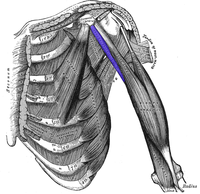
Photo from wikipedia
Unilateral arm paralysis is a common symptom of stroke. In stroke patients, we observed that self-guided biomechanical support by the nonparetic arm unexpectedly triggered electromyographic activity with normal muscle synergies… Click to show full abstract
Unilateral arm paralysis is a common symptom of stroke. In stroke patients, we observed that self-guided biomechanical support by the nonparetic arm unexpectedly triggered electromyographic activity with normal muscle synergies in the paretic arm. The muscle activities on the paretic arm became similar to the muscle activities on the nonparetic arm with self-supported exercises that were quantified by the similarity index (SI). Electromyogram (EMG) signals and functional near-infrared spectroscopy (fNIRS) of the patients (n=54) showed that self-supported exercise can have an immediate effect of improving the muscle activities by 40–80% according to SI quantification, and the muscle activities became much more similar to the muscle activities of the age-matched healthy subjects. Using this self-supported exercise, we investigated whether the recruitment of a patient’s contralesional nervous system could reactivate their ipsilesional neural circuits and stimulate functional recovery. We proposed biofeedback training with self-supported exercise where the muscle activities were visualized to encourage the appropriate neural pathways for activating the muscles of the paretic arm. We developed the biofeedback system and tested the recovery speed with the patients (n=27) for 2 months. The clinical tests showed that self-support-based biofeedback training improved SI approximately by 40%, Stroke Impairment Assessment Set (SIAS) by 35%, and Functional Independence Measure (FIM) by 20%.
Journal Title: IEEE Access
Year Published: 2020
Link to full text (if available)
Share on Social Media: Sign Up to like & get
recommendations!